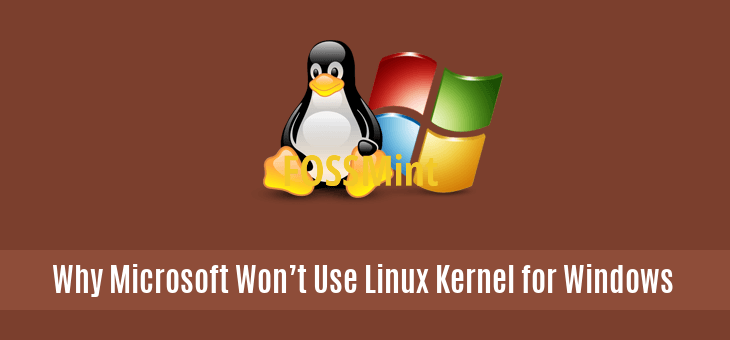In a significant move that surprised many, Microsoft made a groundbreaking announcement back in 2019: Windows 10 would include a full Linux kernel. This integration of two seemingly contrasting operating systems sent shockwaves throughout the tech community. The decision to ship the Linux kernel with Windows heralded a new era of collaboration and innovation. In this blog post, we will explore why this move changes everything and how it benefits users and developers alike.
Bridging the Gap between Linux and Windows
The integration of the Linux kernel into Windows was a bold step towards bridging the gap between two major operating systems. Previously, developers and users often faced challenges when trying to run Linux-based tools or applications on Windows machines. With the Linux kernel natively integrated into Windows, this barrier is shattered, allowing developers to work seamlessly across both platforms. It opens up a wealth of possibilities for cross-platform development, making the lives of developers more productive and efficient.
Enhanced Compatibility and Application Support
By bringing the Linux kernel into Windows, Microsoft has significantly improved compatibility and application support. Linux has a vast ecosystem of powerful tools and software, many of which were previously inaccessible to Windows users. Now, users can leverage Linux-based applications, tools, and utilities directly on their Windows machines without the need for virtualization or dual-boot setups. This expands the software landscape and empowers users to choose from a wider range of applications to meet their specific needs.
Boosting Developer Productivity
Developers often work in heterogeneous environments, where they need to switch between different operating systems to build, test, and deploy their applications. The integration of the Linux kernel in Windows reduces the friction of switching platforms, allowing developers to work seamlessly on projects that require both Linux and Windows tools. It eliminates the overhead of setting up separate development environments or resorting to complex workarounds. This increased productivity and flexibility ultimately benefits both individual developers and organizations as a whole.
Strengthening Open-Source Collaboration
Microsoft’s decision to embrace the Linux kernel demonstrates their commitment to open-source collaboration. It signifies a major shift in the company’s philosophy and further strengthens the bond between Microsoft and the open-source community. By shipping the Linux kernel with Windows, Microsoft acknowledges the value of open-source software and fosters collaboration between developers from different backgrounds. This collaboration has the potential to drive innovation, improve software quality, and create a more inclusive and diverse technology landscape.
Empowering Windows as a Development Platform
With the integration of the Linux kernel, Windows establishes itself as a formidable development platform. It combines the familiarity and widespread adoption of Windows with the power and versatility of Linux. This convergence provides developers with the best of both worlds, allowing them to harness the vast resources available on both platforms. Whether it’s Windows-specific tools or Linux-based development frameworks, developers can choose the right tool for the job without compromising on performance or compatibility.
Improved Performance and Resource Management
The Linux kernel is renowned for its robust performance and efficient resource management capabilities. By integrating it into Windows, Microsoft leverages the strengths of Linux to enhance the overall performance of the operating system. Users can experience improved system responsiveness, better resource allocation, and optimized power management. This integration benefits both everyday users and power users who demand high-performance computing.
Boosting Performance: 10 Effective Tips to Speed Up Your Linux PC
Streamlined Development Environments
Developers often rely on a range of tools, libraries, and frameworks that are native to Linux for their development workflows. With the Linux kernel incorporated into Windows, developers can create streamlined development environments that seamlessly integrate Windows and Linux tools. They can leverage popular Linux-centric technologies such as Docker containers, Kubernetes, and Bash scripting without sacrificing the Windows development experience. This integration simplifies the setup of complex development environments, making it easier to collaborate and share projects across teams.
Enhanced Security and Stability
Linux has a well-deserved reputation for its robust security architecture. By integrating the Linux kernel into Windows, Microsoft can leverage the security features and best practices from the Linux community. This helps strengthen the overall security and stability of the Windows operating system. Users can benefit from the proactive security measures and rapid response to vulnerabilities that Linux is known for, resulting in a more secure and reliable computing environment.
Encouraging Open-Source Contributions
The integration of the Linux kernel with Windows encourages more open-source contributions from developers. It provides a common ground for developers who are passionate about both Windows and Linux to collaborate and contribute to the improvement of both platforms. This convergence fosters a vibrant ecosystem where developers can exchange ideas, share code, and collectively enhance the overall experience for users of both operating systems.
Opening Doors to New Possibilities
The inclusion of the Linux kernel in Windows opens doors to new possibilities in various domains. It encourages innovation and cross-pollination between different software ecosystems. For example, it facilitates the development of new cross-platform applications, IoT solutions, cloud-native technologies, and more. The fusion of Windows and Linux enables users and developers to explore uncharted territories and unleash their creativity to build groundbreaking software solutions.
Windows shipping the Linux kernel represents a paradigm shift in the tech industry. It brings together two major operating systems and fosters collaboration, compatibility, and innovation. The integration enhances the development experience, expands application support, and strengthens the bond between Microsoft and the open-source community. This move has opened up new possibilities for developers and users, empowering them to work seamlessly across different platforms and access a broader range of software. With Windows embracing Linux, the future of computing looks more promising than ever before.













